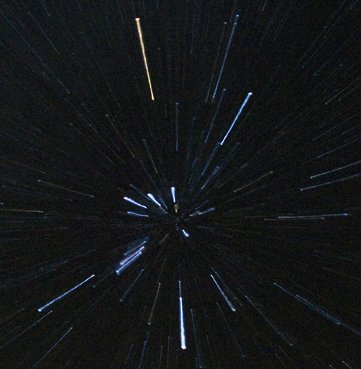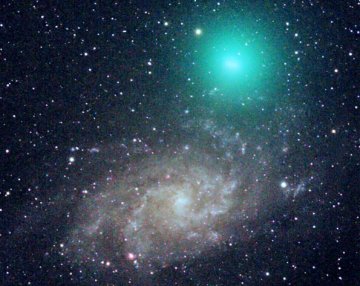METEOR SHOWER: Earth is about to pass through a debris stream from near-Earth asteroid 2003 EH1, producing the annual Quadrantid meteor shower. Forecasters expect a brief but intense peak of 50+ meteors per hour over Earth's northern hemisphere sometime between 0200 UTC and 0700 UTC on Friday morning, Jan. 4th. (Subtract 5 hours to convert UTC to EST.) The timing favors observers in the eastern USA, Europe and western parts of Asia: sky map.
Winter storms frequently hide this shower from observers on the ground. To avoid such problems, a team of astronomers led by Peter Jenniskens of the SETI Institute will fly a plane above the clouds where they can train their cameras on the Quadrantids. Their data may reveal whether asteroid 2003 EH1 is a fragment of a long-dead comet: more.
ORION--WARP 5! "While at the San Antonio Astronomical Association's New Year Eve Star Party, I was taking a widefield image of Orion and thought that I would vary the focal length of the lens," says Bryan Tobias of Fredericksburg, Texas. "This is what I ended up with!"

Photo details: Nikon D300, 14-24mm lens, f/2.8, ISO 1600 20 seconds
"I call this shot Number 1, Orion--Warp 5!" he says. "I used a Nikon D300 with a Nikon lens at all focal lengths from 14mm to 24mm."
This is a good time of year to see Orion--even at impulse speed. The constellation rises in the east at sunset beneath the campfire-red light of Mars: sky map. Watching Orion ascend, you may experience the little-known "constellation illusion." The idea is the same as the Moon illusion; constellations viewed near the horizon look abnormally large. Go outside tonight and look. Can you believe your eyes?
NEW YEARS COMET: Tonight, after sunset, take your binoculars outside and scan the sky right above your head. You may find a little emerald fuzzball--Comet 8P/Tuttle. The comet is making its closest approach to Earth (24 million miles) this week. Shining like a ~6th magnitude star, it is barely visible to the unaided eye, but a fine target for binoculars and backyard telescopes. Sky maps: Jan 2, 3.
On Dec. 30th, in the mountains of northern Italy, Giampaolo Salvato photographed the comet gliding by spiral galaxy M33:

more galaxy-comet encounter photos
"This is a 2 x 5 minute exposure at ISO 1600," says Salvato, who took the picture using his backyard telescope and a Canon 5D digital camera.
The colors in this photo are truly heavenly: The galaxy is blue because of a great number of young and massive blue-white stars outlining the spiral arms. The comet, on the other hand, is green because of cyanogen (CN, a poisonous gas) and diatomic carbon (C2) present in the comet's atmosphere; both substances glow emerald-green when exposed to UV sunlight in the near vacuum of space.



No comments:
Post a Comment